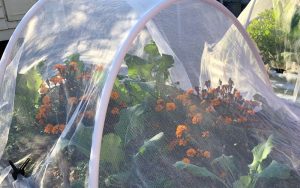Netting for success!
Robin Gale-Baker, from Sustainable Macleod, discusses netting. This is one of a series of articles she has written about growing techniques (see right hand sidebar). She has also written a number of articles about growing various vegetables, herbs and fruit trees.
Purpose of netting
 A major purpose of netting is to prevent both mammals (e.g. rats and possums) and birds from accessing your fruit and vegetables. Be aware, however, that rats can tear holes in a net if hungry enough.
A major purpose of netting is to prevent both mammals (e.g. rats and possums) and birds from accessing your fruit and vegetables. Be aware, however, that rats can tear holes in a net if hungry enough.
Netting is the most successful preventative for Queensland fruit fly in both fruit and vegetables and for this reason is an essential tool in the garden.
Netting is particularly valuable for brassica family plants (including cauliflower, cabbage, Brussel sprouts and broccoli) to deter white cabbage moth for solanaceae family plants (including tomato, eggplant, capsicum and chilli) to deter various caterpillars.
Choice of netting
Netting selection is a vital aspect of insect control in the fruit and veggie garden.
Appropriate mesh size will protect fruit and vegetables from a range of insects while inappropriate mesh size may actually increase the numbers of non-beneficial insects including aphids and thrips.
For all fruit and veggies, my suggestion is that you use white netting with mesh of 1x3mm or 2x2mm.
A smaller mesh size does not allow sufficient ventilation inside the netting, and creates a warm microclimate that is conducive to heavy breeding of certain bugs especially thrips and aphids. What’s more, such mesh is too fine for these bugs to exit and escape. If you wanted to breed these bugs, you would have created the perfect environment to do so!
I prefer the 2x2mm mesh because I can buy it off the roll at Bulleen Art and Garden. Buying off the roll allows me to determine the lengths that I need and it is also much wider than that purchased in packets. Net that is narrow is rarely useful (except perhaps for a low cloche) as it does not have sufficient margins to hang down the sides or for the edges to be weighted or covered.
Netting which is white in colour helps to prevent sunburn on produce.
Finally, cotton or cotton-based netting is preferable to synthetic netting as the latter heats up considerably more.
Timing of netting
The ideal time to net is just after pollination. Netting too early will exclude the pollinators that transfer pollen from flower to flower and will result in a lack of fruit. Netting too late, while better than nothing, is likely to have resulted in some damage to foliage, for example from sucking insects, which weakens the plant.
Placement of netting
Netting needs to be comprehensive. Any holes need to be sewn up and the edges need to be weighed down with weights or soil. Net over trees should either be weighted around the base or tied firmly to the trunk.
Rats can climb up netting so, in the case of wooden wicking beds, make sure that the netting is not left to drag on the ground and secured instead at the top edge of the bed. Corrugated beds are too slippery for rats to climb but, likewise, keep the net as high off the ground as possible.
Complements to netting
The best way of controlling non-beneficial insects is actually to create an environment that supports beneficial insects which will eat the non-beneficials at the soft body stage. Plant with as much biodiversity as possible. White and yellow flowering plants are particularly attractive to beneficial insects.

Our established orange tree was producing magnificently 8 years ago (around 800 oranges). But possums and cockatoos took 100s. I gave it a renovation prune and netted it after possums kept decimating new growth. It now has a large netted frame ( netting is about .5 cm squares) and is very healthy and well maintained. However the yield is much reduced. Only about 30 oranges. My son thinks the net is hindering pollinators, although I have seen bees on flowers, but maybe not enough pollinators are getting in. Should I lift the net at certain times, at least during the day? Really appreciate your advice!
Hi Jan,
Your son is right! You should lift the net for all the time that the tree has flowers and only lower it once the fruit has started to become sizeable.